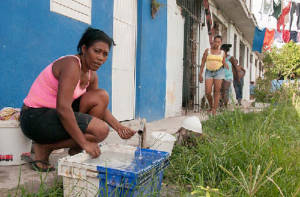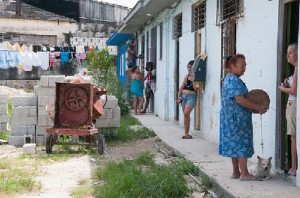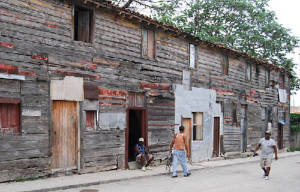Housing in Cuba: An Unresolved Nightmare

HAVANA TIMES — “No-one from the Ministry of Housing has come around to see the finished house,” “this is the first time in 10 years that journalists have paid any attention to people living in shelters,” “the housing project was completed 3 months ago and we still don’t have running water,” “this has been one lie after the other,” “we’re going to be packed in like sardines.”
The people living in Havana’s “La Granjita” shelter are housewives, pensioners, teachers, students, health professionals and translators. All of them live with their families in this former guest house and complain about the scant attention they get from the Housing Department.
The government recently acknowledged a 600-thousand-house deficit and announced it would construct housing for those living in shelters. Nearly 28 thousand units would need to be constructed in Havana alone to house all who have lost their homes and are currently living in relatively safe but inadequate locales.
Building efforts have already begun at “La Granjita”, but residents complain of shoddy workmanship, theft of construction materials, unventilated rooms, apartments without running water and leaky roofs.
“Adequate Housing”
“My house burned down and we were left out in the street. We survived thanks to our neighbors, who let us cook and bathe in their home,” Yoanka Penda told us, adding: “it was very hard for us because I was only 13 and already the mother of a small child.”

Life became hard for her indeed: after the fire, she built a wooden house and “hurricane Michel tore it down.” As a teenager, her son spent all of his high school years in the rural boarding school because he had nowhere else to go.
She was assigned a room at “La Granjita” 10 years ago. This past June, she was given a 2-bedroom apartment, but “we still don’t have running water, the doors are coming off their hinges, the roofs are leaking, the rooms are unventilated, and they have the nerve to tell me this is ‘adequate housing.’”
She tells us that “we’ve been assigned a construction brigade and no one from Housing even comes around to see how the building is coming along. That’s why they always do a bad job, the building brigades leave the work unfinished and steal materials.”
The Housing Department: “Fibs and Lies”
Maria del Carmen Linares is the chair of the block’s Committee for the Defense of the Revolution (CDR). She tells us that some 90 people (14 families) live at the “La Granjita” shelter. Despite her position, she does not conceal her irritation about Housing authorities.
“We have no running water here, all we get is a trickle. We have no cistern, no tanks, no water pump. At every meeting we have, the people from Housing tell us they’re going to fix the problem, but nothing changes afterwards. They haven’t done anything; it’s all been fibs and lies.”

“The people from Housing and us agreed they would build 14 1, 2 and 3-bedroom apartments, but now they want to build 17 2-bedroom units. We feel that you can’t put an 8-person family in 2-bedroom apartment, we’re going to be packed in like sardines if they do.”
“We have no one to turn to and have no control over the use of construction materials,” she says, adding: “No one from Housing comes around here. The administrator was here in July. She took August off, and is going away on vacation in September.”
Bread and Sugared Water
Jacqueline Marcos Oviedo is a teacher. She’s been living in the shelter for 3 years without a food ration booklet, because “every time I go see Juan Alberto Nachi, he’s not there and no Housing official in the neighborhood knows where he is.”
“Every week, I take time off classes to go look for him, because I need my ration booklet to get my food. Sometimes, the only thing I have for breakfast is a piece of bread and sugared water”, adding that “I cook using a gas cylinder that my neighbors lend me, or I bring home the food from the school, for my children.”
Marieta Santana is 23. She has a university degree in English and French. For her, “coming to live in a shelter, leaving behind my neighborhood, neighbors and friends, was traumatic.” She complains that the lack of public transportation where she lives keeps her from going out. “The only thing I’ve learned to do here is stay in the house.”
She believes “La Granjita” could improve, but it would need more than bigger apartments. “They have to asphalt the roads here, because they’re all overgrown with weeds, and that attracts frogs, rats, mosquitos and cockroaches. When it rains, the place turns into a swamp and you can’t even get into the building.”
“It’s a Mess”

Dulce Maria Perez is a pensioner who worked as a draftsperson for 34 years. She’s been living at the shelter for 10 years, with no hopes of getting an apartment. They changed the construction plans. They are no longer planning to build 1-bedroom apartments, and she lives all by herself.
She tells us that “we make no progress. They build something and then they tear it down” because of a lack of planning. “The first thing you’d have to do is put together a decent plan, but they started building without a general idea of what they were going to do with the sewage water, the electricity and the water supply.”
“What they’ve done is a mess, but I’m not worried. I’ve been able to get by without a sink, without a place to wash in, washing things and throwing the water out into the street. I’ve had two heart attacks since moving here and I’m not going to get wound up anymore.”
The people at “La Granjita” are happy to see the Cuban press finally pay attention to them and that the government has decided to build them homes. Dulce tells us that “the good thing about all this is how bad things have gotten, because no one ever does anything until something blows up in their faces.”






Yeah this is really sad that they don’t all have adequate houses!
You can ‘steal this nightmare’ if you give up fundamental civil liberties, open yourself up to arbitrary detentions for anything the govt deems against it’s communist ethos – – “not free” I believe some Human Rights metric labeled it… And those owners in the 90% can’t “own” their homes like those in private property oriented societies – accruing wealth through markets rising – their homes deteriorate because there’s no incentive for upkeep – not to mention lack of general funds
90% home ownership rate. Is there a way I can steal this nightmare?
Housing in my part of Canada seems to be addressed only after some unliveable circumstance commands media attention as well. Social housing on Indian Reserves (especially) tends to evaporate due to the similar forces laid out in your article. I like how your story suggests a ray of hope. It seems like strong visuals & media attention will eventually force someone in charge to act. In Canada, this rarely happens for long enough to see some follow through, however, so I can only hope that you see some improvement of your despair.
It WILL come -just probably so that the spotlight moves away.
Housing in Cuba is a nightmare indeed. From decaying houses to ruins: all part of daily reality in Cuba.
Up to 500,000 houses in Cuba are in need of repair or need to be constructed. Various generations live in the same house leading to overcrowding and problems (social life, health). Water, gas and electricity are failing. Unsafe conditions (water tanks, electricity, contaminated drinking water, open sewage) abound.
Another “achievement” of the revolution.
The revolution was never very good at actually building anything; Violence and distraction yes, stealing and “redistributing” (read keeping it for yourself), yes. ….planing and building? Not so much